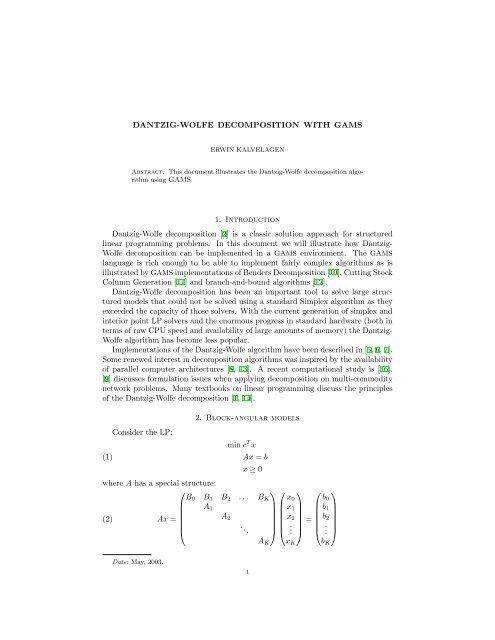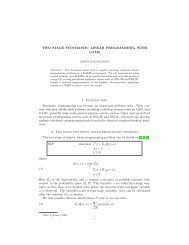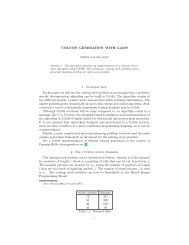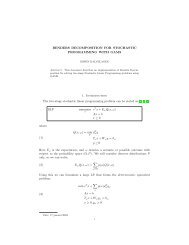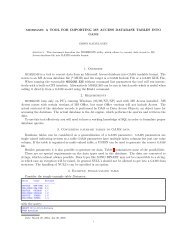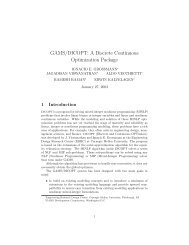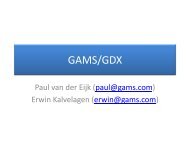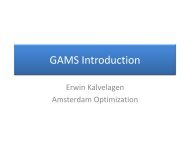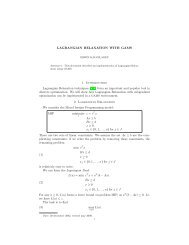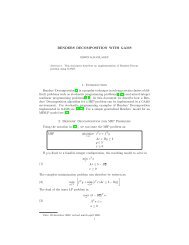Dantzig-Wolfe Decomposition with GAMS - Amsterdam Optimization ...
Dantzig-Wolfe Decomposition with GAMS - Amsterdam Optimization ...
Dantzig-Wolfe Decomposition with GAMS - Amsterdam Optimization ...
You also want an ePaper? Increase the reach of your titles
YUMPU automatically turns print PDFs into web optimized ePapers that Google loves.
DANTZIG-WOLFE DECOMPOSITION WITH <strong>GAMS</strong>ERWIN KALVELAGENAbstract. This document illustrates the <strong>Dantzig</strong>-<strong>Wolfe</strong> decomposition algorithmusing <strong>GAMS</strong>.1. Introduction<strong>Dantzig</strong>-<strong>Wolfe</strong> decomposition [2] is a classic solution approach for structuredlinear programming problems. In this document we will illustrate how <strong>Dantzig</strong>-<strong>Wolfe</strong> decomposition can be implemented in a <strong>GAMS</strong> environment. The <strong>GAMS</strong>language is rich enough to be able to implement fairly complex algorithms as isillustrated by <strong>GAMS</strong> implementations of Benders <strong>Decomposition</strong> [10], Cutting StockColumn Generation [11] and branch-and-bound algorithms [12].<strong>Dantzig</strong>-<strong>Wolfe</strong> decomposition has been an important tool to solve large structuredmodels that could not be solved using a standard Simplex algorithm as theyexceeded the capacity of those solvers. With the current generation of simplex andinterior point LP solvers and the enormous progress in standard hardware (both interms of raw CPU speed and availability of large amounts of memory) the <strong>Dantzig</strong>-<strong>Wolfe</strong> algorithm has become less popular.Implementations of the <strong>Dantzig</strong>-<strong>Wolfe</strong> algorithm have been described in [5, 6, 7].Some renewed interest in decomposition algorithms was inspired by the availabilityof parallel computer architectures [8, 13]. A recent computational study is [16].[9] discusses formulation issues when applying decomposition on multi-commoditynetwork problems. Many textbooks on linear programming discuss the principlesof the <strong>Dantzig</strong>-<strong>Wolfe</strong> decomposition [1, 14].(1)Consider the LP:2. Block-angular modelsmin c T xAx = bx ≥ 0where A has a special structure:⎛⎞ ⎛ ⎞ ⎛ ⎞B 0 B 1 B 2 . . . B K x 0 b 0A 1 x 1b 1(2) Ax =A 2 x 2=b 2 ⎜⎝. ..⎟ ⎜ ⎟ ⎜ ⎟⎠ ⎝ . ⎠ ⎝ . ⎠A K x K b KDate: May, 2003.1
2 ERWIN KALVELAGENThe constraints(3)K∑B k x k = b 0k=0corresponding to the top row of sub-matrices are called the coupling constraints.The idea of the <strong>Dantzig</strong>-<strong>Wolfe</strong> approach is to decompose this problem, such thatnever a problem has to be solved <strong>with</strong> all sub-problems A k x k = b k included. Insteada master problem is devised which only concentrates on the coupling constraints,and the sub-problems are solved individually. As a result only a series of smallerproblems need to be solved.3. Minkowski’s Representation TheoremConsider the feasible region of an LP problem:(4) P = {x|Ax = b, x ≥ 0}If P is bounded then we can characterize any point x ∈ P as a linear combinationof its extreme points x (j) :(5)x = ∑ λ j x (j)j∑λ j = 1jλ j ≥ 0If the feasible region can not assumed to be bounded we need to introduce thefollowing:(6)x = ∑ λ j x (j) + ∑ji∑λ j = 1jλ j ≥ 0µ i ≥ 0µ i r (i)where r (i) are the extreme rays of P . The above expression for x is sometimescalled Minkowski’s Representation Theorem[15]. The constraint ∑ j λ j = 1 is alsoknown as the convexity constraint.A more compact formulation is sometimes used:(7)where(8) δ j =x = ∑ λ j x (j)j∑δ j λ j = 1jλ j ≥ 0{1 if x (j) is an extreme point0 if x (j) is an extreme ray
DANTZIG-WOLFE DECOMPOSITION WITH <strong>GAMS</strong> 3I.e. we can describe the problem in terms of variables λ instead of the originalvariables x. In practice this reformulation can not be applied directly, as the numberof variables λ j becomes very large.4. The decompositionThe K subproblems are dealing <strong>with</strong> the constraints(9)A k x k = b kx k ≥ 0while the Master Problem is characterized by the equations:(10)min ∑ c T k x kk∑B k x k = b 0kx 0 ≥ 0We can substitute equation 7 into 10, resulting in:(11)K∑min c T 0 x 0 +p k∑k=1 j=1K∑B 0 x 0 +p k∑j=1x 0 ≥ 0λ k,j ≥ 0p k∑k=1 j=1(c T k x (j)k)λ k,j(B k x (j)k )λ k,j = b 0δ k,j λ k,j = 1 for k = 1, . . . , KThis is a huge LP. Although the number of rows is reduced, the number of extremepoints and rays x (j)kof each subproblem is very large, resulting in an enormousnumber of variables λ k,j . However many of these variables will be non-basic atzero, and need not be part of the problem. The idea is that only variables <strong>with</strong> apromising reduced cost will be considered in what is also known as a delayed columngeneration algorithm.The model <strong>with</strong> only a small number of the λ variables, compactly written as:min c T 0 x 0 + c T λ ′(12)B 0 x 0 + Bλ ′ = b 0∆λ ′ = 1x 0 ≥ 0λ ′ ≥ 0is called the restricted master problem. The missing variables are fixed at zero.The restricted master problem is not fixed in size: variables will be added to thisproblem during execution of the algorithm.
4 ERWIN KALVELAGENSub 1DualsSub 2MasterNew columns.Sub KFigure 1. Communication between restricted master and sub-problemsThe attractiveness of a variable λ k,j can be measured by its reduced cost 1 . Ifwe denote the dual variables for constraint B 0 x 0 + Bλ ′ = b 0 by π 1 and those forthe convexity constraints ∑ j δ k,jλ ′ k,j= 1 by π(k) 2 , then reduced cost for the masterproblem look like:((14) σ k,j = (c T k x (j)k) − Bk x (j) )πT k = (c T k − π1 T B k )x (j)kδ − π(k) 2 δ k,jk,jAssuming the sub-problem to be bounded, the most attractive bfs (basic feasiblesolution) x k to enter the master problem is found by maximizing the reduced costgiving the following LP:(15)min σ k = (c T k − π1 T B k )x k − π (k)x2kB k x x = b kx k ≥ 0The operation to find these reduced costs is often called Pricing. If σk ∗ < 0 we canintroduce the a new column λ k,j to the master, <strong>with</strong> a cost coefficient of c T k x∗ k .A basic <strong>Dantzig</strong>-<strong>Wolfe</strong> decomposition algorithm can now be formulated:<strong>Dantzig</strong>-<strong>Wolfe</strong> decomposition algorithm.{initialization}Choose initial subsets of variables.while true do1 The reduced cost of a variable xj is(13) σ j = c j − π T A jwhere A j is the column of A corresponding to variable x j , and π are the duals.
DANTZIG-WOLFE DECOMPOSITION WITH <strong>GAMS</strong> 5{Master problem}Solve the restricted master problem.π 1 := duals of coupling constraintsπ (k)2 := duals of the k th convexity constraint{Sub problems}for k=1,. . . ,K doPlug π 1 and π (k)2 into sub-problem kSolve sub-problem kif σk ∗ < 0 thenAdd proposal x ∗ kto the restricted masterend ifend forif No proposals generated thenStop: optimalend ifend while(16)5. InitializationWe did not pay attention to the initialization of the decomposition.The first thing we can do is solve each sub-problem:min c T k x kA k x k = b kx k ≥ 0If any of the subproblems is infeasible, the original problem is infeasible. Otherwise,we can use the optimal values x ∗ k(or the unbounded rays) to generate an initial setof proposals.6. Phase I/II algorithmThe initial proposals may violate the coupling constraints. We can formulatea Phase I problem by introducing artificial variables and minimizing those. Theuse of artificial variables is explained in any textbook on Linear Programming (e.g.[1, 14]). It is noted that the reduced cost for a Phase I problem are slightly differentfrom the Phase II problem.As an example consider that the coupling constraints are∑(17)x j ≤ bWe can add an artificial variable x a ≥ 0 as follows:∑(18)x j − x a ≤ bThe phase I objective will be:(19) min x ajjThe reduced cost of a variable x j is now as in equation (14) but <strong>with</strong> c T k = 0.It is noted that it is important to remove artificials once a phase II starts. Wedo this in the example code by fixing the artificial variables to zero.
6 ERWIN KALVELAGEN7. Example: multi-commodity network flowThe multi-commodity network flow (MCNF) problem can be stated as:min ∑ ∑c k i,jx k i,jk∈K (i,j)∈A∑x k i,j −∑x k j,i = b k j(20)(i,j)∈A (j,i)∈A∑x k i,j ≤ u i,jk∈Kx k i,j ≥ 0This is sometimes called the node-arc formulation.<strong>Dantzig</strong>-<strong>Wolfe</strong> decomposition is a well-known solution strategy for this type ofproblems. For each commodity a subproblem is created.We consider here a multi-commodity transportation problem:min ∑ ∑c k i,jx k i,jk∈K (i,j)∑x k i,j = supplyik(21)j∑x k i,j = demand k ji∑x k i,j ≤ u i,jk∈Kx k i,j ≥ 0<strong>with</strong> data from [4]. A similar <strong>Dantzig</strong>-<strong>Wolfe</strong> decomposition algorithm written inAMPL can be found in [3].Model dw.gms. 2$ontext<strong>Dantzig</strong>-<strong>Wolfe</strong> <strong>Decomposition</strong> <strong>with</strong> <strong>GAMS</strong>Reference:http://www.gams.com/~erwin/dw/dw.pdfErwin Kalvelagen, April 2003$offtextsetsi ’origins’ /GARY, CLEV, PITT /j ’destinations’ /FRA, DET, LAN, WIN, STL, FRE, LAF /p ’products’ /bands, coils, plate/;table supply(p,i)GARY CLEV PITTbands 400 700 800coils 800 1600 1800plate 200 300 300;2 http://www.amsterdamoptimization.com/models/dw/dw.gms
DANTZIG-WOLFE DECOMPOSITION WITH <strong>GAMS</strong> 7table demand(p,j)FRA DET LAN WIN STL FRE LAFbands 300 300 100 75 650 225 250coils 500 750 400 250 950 850 500plate 100 100 0 50 200 100 250;parameter limit(i,j);limit(i,j) = 625;table cost(p,i,j) ’unit cost’FRA DET LAN WIN STL FRE LAFBANDS.GARY 30 10 8 10 11 71 6BANDS.CLEV 22 7 10 7 21 82 13BANDS.PITT 19 11 12 10 25 83 15COILS.GARY 39 14 11 14 16 82 8COILS.CLEV 27 9 12 9 26 95 17COILS.PITT 24 14 17 13 28 99 20PLATE.GARY 41 15 12 16 17 86 8PLATE.CLEV 29 9 13 9 28 99 18PLATE.PITT 26 14 17 13 31 104 20;*-----------------------------------------------------------------------* direct LP formulation*-----------------------------------------------------------------------positive variablex(i,j,p) ’shipments’;variablez ’objective variable’;equationsobjsupplyc(i,p)demandc(j,p)limitc(i,j);obj..z =e= sum((i,j,p), cost(p,i,j)*x(i,j,p));supplyc(i,p).. sum(j, x(i,j,p)) =e= supply(p,i);demandc(j,p).. sum(i, x(i,j,p)) =e= demand(p,j);limitc(i,j).. sum(p, x(i,j,p)) =l= limit(i,j);model m/all/;solve m minimizing z using lp;*-----------------------------------------------------------------------* subproblems*-----------------------------------------------------------------------positive variables xsub(i,j);variables zsub;parameterss(i) ’supply’d(j) ’demand’c(i,j) ’cost coefficients’pi1(i,j) ’dual of limit’pi2(p) ’dual of convexity constraint’
8 ERWIN KALVELAGEN;pi2pequationssupply_sub(i)demand_sub(j)rc1_subrc2_sub;’supply equation for single product’’demand equation for single product’’phase 1 objective’’phase 2 objective’supply_sub(i).. sum(j, xsub(i,j)) =e= s(i);demand_sub(j).. sum(i, xsub(i,j)) =e= d(j);rc1_sub.. zsub =e= sum((i,j), -pi1(i,j)*xsub(i,j)) - pi2p;rc2_sub.. zsub =e= sum((i,j), (c(i,j)-pi1(i,j))*xsub(i,j)) - pi2p;model sub1 ’phase 1 subproblem’ /supply_sub, demand_sub, rc1_sub/;model sub2 ’phase 2 subproblem’ /supply_sub, demand_sub, rc2_sub/;*-----------------------------------------------------------------------* master problem*-----------------------------------------------------------------------set k ’proposal count’ /proposal1*proposal1000/;set pk(p,k);pk(p,k) = no;parameter proposal(i,j,p,k);parameter proposalcost(p,k);proposal(i,j,p,k) = 0;proposalcost(p,k) = 0;positive variableslambda(p,k)excess ’artificial variable’;variable zmaster;equationsobj1_master ’phase 1 objective’obj2_master ’phase 2 objective’limit_master(i,j)convex_master;obj1_master..obj2_master..zmaster =e= excess;zmaster =e= sum(pk, proposalcost(pk)*lambda(pk));limit_master(i,j)..sum(pk, proposal(i,j,pk)*lambda(pk)) =l= limit(i,j) + excess;convex_master(p).. sum(pk(p,k), lambda(p,k)) =e= 1;model master1 ’phase 1 master’ /obj1_master, limit_master, convex_master/;model master2 ’phase 2 master’ /obj2_master, limit_master, convex_master/;*-----------------------------------------------------------------------* options to reduce solver output*-----------------------------------------------------------------------option limrow=0;option limcol=0;master1.solprint = 2;master2.solprint = 2;sub1.solprint = 2;
DANTZIG-WOLFE DECOMPOSITION WITH <strong>GAMS</strong> 9sub2.solprint = 2;*-----------------------------------------------------------------------* options to speed up solver execution*-----------------------------------------------------------------------master1.solvelink = 2;master2.solvelink = 2;sub1.solvelink = 2;sub2.solvelink = 2;*-----------------------------------------------------------------------* DANTZIG-WOLFE INITIALIZATION PHASE* test subproblems for feasibility* create initial set of proposals*-----------------------------------------------------------------------display "-----------------------------------------------------------------","INITIALIZATION PHASE","-----------------------------------------------------------------";set kk(k) ’current proposal’;kk(’proposal1’) = yes;loop(p,** solve subproblem, check feasibility*c(i,j) = cost(p,i,j);s(i) = supply(p,i);d(j) = demand(p,j);pi1(i,j) = 0;pi2p = 0;solve sub2 using lp minimizing zsub;abort$(sub2.modelstat = 4) "SUBPROBLEM IS INFEASIBLE: ORIGINAL MODEL IS INFEASIBLE";abort$(sub2.modelstat 1) "SUBPROBLEM NOT SOLVED TO OPTIMALITY";** proposal generation*proposal(i,j,p,kk) = xsub.l(i,j);proposalcost(p,kk) = sum((i,j), c(i,j)*xsub.l(i,j));pk(p,kk) = yes;kk(k) = kk(k-1););option proposal:2:2:2;display proposal;*-----------------------------------------------------------------------* DANTZIG-WOLFE ALGORITHM* while (true) do* solve restricted master* solve subproblems* until no more proposals*-----------------------------------------------------------------------set iter ’maximum iterations’ /iter1*iter15/;scalar done /0/;scalar count /0/;scalar phase /1/;scalar iteration;loop(iter$(not done),iteration = ord(iter);display "-----------------------------------------------------------------",iteration,"-----------------------------------------------------------------";
10 ERWIN KALVELAGEN** solve master problem to get duals*if (phase=1,solve master1 minimizing zmaster using lp;abort$(master1.modelstat 1) "MASTERPROBLEM NOT SOLVED TO OPTIMALITY";if (excess.l < 0.0001,display "Switching to phase 2";phase = 2;excess.fx = 0;););if (phase=2,solve master2 minimizing zmaster using lp;abort$(master2.modelstat 1) "MASTERPROBLEM NOT SOLVED TO OPTIMALITY";);pi1(i,j) = limit_master.m(i,j);pi2(p) = convex_master.m(p);count = 0;loop(p$(not done),** solve each subproblem*c(i,j) = cost(p,i,j);s(i) = supply(p,i);d(j) = demand(p,j);pi2p = pi2(p);if (phase=1,solve sub1 using lp minimizing zsub;abort$(sub1.modelstat = 4) "SUBPROBLEM IS INFEASIBLE: ORIGINAL MODEL IS INFEASIBLE";abort$(sub1.modelstat 1) "SUBPROBLEM NOT SOLVED TO OPTIMALITY";elsesolve sub2 using lp minimizing zsub;abort$(sub2.modelstat = 4) "SUBPROBLEM IS INFEASIBLE: ORIGINAL MODEL IS INFEASIBLE";abort$(sub2.modelstat 1) "SUBPROBLEM NOT SOLVED TO OPTIMALITY";);** proposal*if (zsub.l < -0.0001,count = count + 1;display "new proposal", count,xsub.l;proposal(i,j,p,kk) = xsub.l(i,j);proposalcost(p,kk) = sum((i,j), c(i,j)*xsub.l(i,j));pk(p,kk) = yes;kk(k) = kk(k-1);););** no new proposals?*abort$(count = 0 and phase = 1) "PROBLEM IS INFEASIBLE";done$(count = 0 and phase = 2) = 1;);abort$(not done) "Out of iterations";*-----------------------------------------------------------------------* recover solution*-----------------------------------------------------------------------
DANTZIG-WOLFE DECOMPOSITION WITH <strong>GAMS</strong> 11parameter xsol(i,j,p);xsol(i,j,p) = sum(pk(p,k), proposal(i,j,pk)*lambda.l(pk));display xsol;parameter totalcost;totalcost = sum((i,j,p), cost(p,i,j)*xsol(i,j,p));display totalcost;The reported solution is:---- 317 PARAMETER xsolbands coils plateGARY.STL 400.000 64.099 160.901GARY.FRE 625.000GARY.LAF 110.901 39.099CLEV.FRA 264.099 10.901CLEV.DET 67.906 457.094 100.000CLEV.LAN 400.000CLEV.WIN 43.972 169.025 50.000CLEV.STL 250.000 260.901 39.099CLEV.FRE 162.003 100.000CLEV.LAF 74.024 150.976PITT.FRA 35.901 500.000 89.099PITT.DET 232.094 292.906PITT.LAN 100.000PITT.WIN 31.028 80.975PITT.STL 625.000PITT.FRE 225.000 62.997PITT.LAF 175.976 238.123 210.901---- 321 PARAMETER totalcost = 199500.000References1. V. Chvatal, Linear programming, Freeman, 1983.2. G. B. <strong>Dantzig</strong> and P. <strong>Wolfe</strong>, <strong>Decomposition</strong> principle for linear programs, Operations Research8 (1960), 101–111.3. R. Fourer and D. Gay, Looping <strong>with</strong> ampl, http://www.netlib.org/ampl/looping/, 1995.4. R. Fourer, D. Gay, and B. Kernighan, AMPL: A modelling language for mathematical programming,Boyd & Fraser, 1993.5. J. K. Ho and E. Loute, An advanced implementation of the <strong>Dantzig</strong>-<strong>Wolfe</strong> decompositionalgorithm for linear programming, Mathematical Programming 20 (1981), 303–326.6. , Computational experience <strong>with</strong> advanced implementation of decomposition algorithmsfor linear programming, Mathematical Programming 27 (1983), 283–290.7. James K. Ho and R. P. Sundarraj, DECOMP: an implementation of <strong>Dantzig</strong>-<strong>Wolfe</strong> decompositionfor linear programming, Lecture Notes in Economics and Mathematical Systems, vol.338, Springer-Verlag, 1989.8. , Distributed nested decomposition of staircase linear programs, ACM Transactions onMathematical Software (TOMS) 23 (1997), no. 2, 148–173.9. K. L. Jones, I. J. Lustig, J. M. Farvolden, and W. B. Powell, Multicommodity network flows:The impact of formulation on decomposition, Mathematical Programming 62 (1993), 95–117.10. Erwin Kalvelagen, Benders decomposition <strong>with</strong> <strong>GAMS</strong>, http://www.amsterdamoptimization.com/pdf/benders.pdf, December 2002.11. , Column generation <strong>with</strong> <strong>GAMS</strong>, http://www.amsterdamoptimization.com/pdf/colgen.pdf, December 2002.12. , Branch-and-bound methods for an MINLP model <strong>with</strong> semi-continuous variables,http://www.amsterdamoptimization/pdf/bb.pdf, April 2003.13. Deepankar Medhi, <strong>Decomposition</strong> of structured large-scale optimization problems and paralleloptimization, Tech. Report 718, Computer Sciences Department, University Of Wisconsin,September 1987.
12 ERWIN KALVELAGEN14. Katta G. Murty, Linear programming, Wiley, 1983.15. George L. Nemhauser and Laurence A. Wolsey, Integer and combinatorial optimization, InterscienceSeries in Discrete Mathematics and <strong>Optimization</strong>, Wiley, 1988.16. James Richard Tebboth, A computational study of <strong>Dantzig</strong>-<strong>Wolfe</strong> decomposition, Ph.D. thesis,University of Buckingham, December 2001.<strong>Amsterdam</strong> <strong>Optimization</strong> Modeling Group LLC, Washington D.C./The HagueE-mail address: erwin@amsterdamoptimization.com


